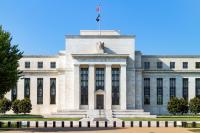
Emmanuel Petit, General Partner, Head of Fixed Income
Philippe Lomné Fixed Income Portfolio Manager Specialisation: IG Credit IG & Crossover
The resurgence of trade tensions has rekindled inflationary pressures and accentuated monetary policy divergences between the US and Europe. While the environment remains fraught with uncertainty, credit market yields and persistently solid corporate fundamentals continue to offer investors attractive prospects.
The prospect of widespread rate cuts has been overtaken by a more complex geopolitical reality. Trade tensions, particularly due to the introduction of new tariffs by the United States, have reignited inflationary pressures, leading to a rise in long-term interest rates and concerns about the trajectory of the U.S. economy. One-year inflation expectations now exceed 3.3% (1), and uncertainty is growing amid volatile economic indicators.
In this context, the U.S. Federal Reserve remains cautious, much to Donald Trump’s dismay. The US President has even decided to engage in a standoff with the Fed Chair—whom he himself appointed during his previous term—who remains, for now, steadfast and maintains the status quo, judging the economic situation as not conducive to monetary easing. The U.S. labor market remains strong, with companies continuing to post solid earnings and showing no signs of adjusting their wage policies. As a result, a price-wage spiral appears to be taking hold, and investors who had anticipated four rate cuts at the beginning of the year now expect only two.
At the same time, the widening U.S. budget deficit and the quantitative tightening initiated by the Fed since 2022 are causing a surge in net supply of government bonds. Nearly 30% of U.S. debt will need to be refinanced in 2025, a level above the historical average of around 22% (2), while the country’s credit rating was recently downgraded. With the Fed’s key rate currently between 4.25% and 4.75%, the sustainability of this debt is in question, and bond yields are rising. Foreign investors, led by China, appear to be turning away from this asset class, increasing pressure on long-term rates and fueling fears of a broader international investor pullback. Confidence in the U.S. dollar itself could begin to erode.
Monetary policy divergence has intensified in recent months as the ECB continues to cut rates, maintaining its steady pace. After a final cut in June, another is expected by year-end. Moreover, German and European stimulus plans have triggered a rebound in the Eurozone. Although modest, Europe’s economic momentum is holding. Financing needs are growing and supporting long-term rates, leading to a steepening of the yield curve.
While the sustainability of sovereign debt is under scrutiny, companies are showing strong fundamentals that could help them withstand potential macroeconomic shocks. Since the beginning of the year, investors have tended to favor credit. Elevated rates combined with specific credit premiums allow for higher returns than government debt.
In this environment, we maintain a cautious and opportunistic positioning. The market may be overly optimistic in response to Donald Trump’s recent reversals on delaying tariff implementation. Tariffs remain higher than before he took office, and we await the outcome once the 90-day pause expires. Consequently, we remain vigilant regarding sectors most exposed to trade tensions, such as the automotive industry. Additionally, we maintain significant exposure to financials, which we have tended to increase following the April correction. We remain convinced of the potential of this asset class given the solid fundamentals of sector players.
We have gradually reduced our portfolios’ interest rate sensitivity as rates declined. At the same time, we have extended maturities as subscriptions came in, to avoid dilution and benefit from the steepening yield curves. We believe that within the Investment Grade (3) segment, the best-rated bonds with maturities of 5 to 10 years offer the most attractive opportunities due to their excess yield. The carry makes this asset class naturally appealing, and the decorrelation between spreads and rates moderates its volatility, as each effect offsets the other.
We therefore consider the current situation to be relatively comfortable. Credit remains expensive, despite the volatility episode last April, but yields remain attractive due to the level of interest rates. Corporate fundamentals are strong, flows are present—particularly in Investment Grade—and opportunities are emerging sporadically. The prevailing uncertainty, while prompting us to remain cautious—especially due to the risk of escalation in the trade war—also generates opportunities. This situation justifies maintaining liquidity pockets to quickly seize opportunities when valuations become more attractive. In an environment where announcements often precede real impacts, discipline and responsiveness remain our best assets.
For more information, visit Rothschild & Co AM website.
[1] Source: BLS, S&P Global, April 2025.
[2] Source: Bloomberg, 16/05/2025.
[3] Debt securities issued by companies or governments rated between AAA and BBB- by Standard & Poor's.
Past performance is not a reliable indicator of future performance and is not constant over time. The characteristics/objectives/strategies mentioned above are indicative and subject to change without notice. This analysis is only valid at the time of writing. The geographical and sector allocations and distributions are not fixed and may change over time within the limits of the SICAV fund’s prospectus
The information, comments and analyses in this document are provided for information purposes only and should not be construed as an investment or tax advice, or as an investment recommendation from Rothschild & Co Asset Management.







